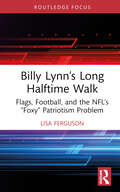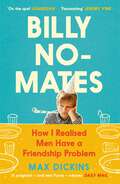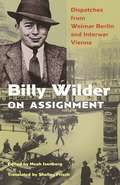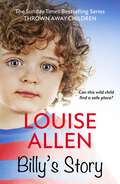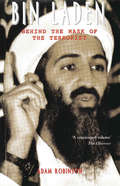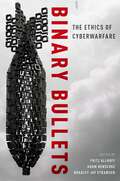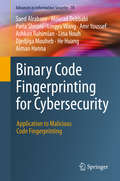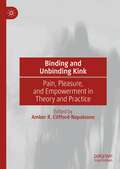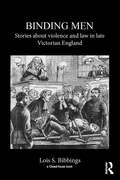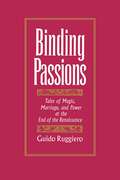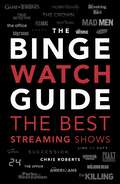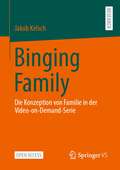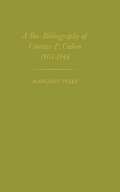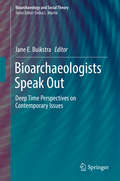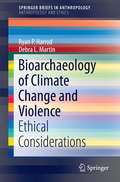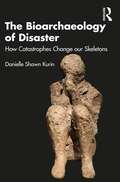- Table View
- List View
Billy Lynn’s Long Halftime Walk: Flags, Football, and the NFL’s “Foxy” Patriotism Problem (Routledge Focus on Literature)
by Lisa FergusonThis book examines how the game of football and militarism have historically overlapped due to their shared celebration of strength, might, and besting a clear and definitive foe. Nevertheless, since September 11, a variety of staged patriotic vignettes dominated most NFL broadcasts, giving the once easy and unforced union a stilted feel. That the War on Terror became a fixture of modern- day Super Bowls was easy to portend; what was more difficult to predict was the imprint it would leave on U.S. citizens and American politics. Ben Fountain’s award- winning novel, Billy Lynn’s Long Halftime Walk, reveals what passes for patriotism in a country that has reduced the sober and stark reality of combat to pageantry and production for the crowd back home, leaving our troops to unwittingly play the part of entertainers, destined to be sexualized just like the cheerleaders and dancers so frequently performing alongside them.
Billy No-Mates: How I Realised Men Have a Friendship Problem
by Max Dickins‘Where have all my friends gone?’ When Max Dickins decided to propose to his girlfriend, he realised there was no one he could call on to be his best man. He quickly learned that that he wasn’t the only man struggling with friendships. For decades, countless studies from across the world have confirmed that men have fewer close friends than women – and the problem gets worse the older men get. But what goes wrong? And what can men do about it? Dickins is going to find out. His funny and charmingly candid search takes him to the doors of world-leading experts. It forces him to examine the friendships he’s had over the years, and where they have foundered. And, briefly, it sends him to the website ‘Rent A Friend’, where he pays someone to hang out with him. But let’s not dwell on that. Join Max as he takes a defibrillator to his social life. As he ultimately discovers that if he wants a Best Man, then he needs to be a better man.
Billy Says... Series: Six therapeutic storybooks to help children on their journey through fostering or adoption (PDF)
by Joanne AlperThis series of six picture books guides children through a range of issues relating to fostering and adoption by focusing on the experiences of a five-year-old girl called Kirsty and her magic doll Billy. Billy talks to Kirsty, explains what is happening to her and explores Kirsty's feelings during her journey from an abusive home to a loving adoptive family. In the series, Billy says... · Book 1 "It's not your fault" explores children's feelings when they are living in neglectful families. · Book 2 "You should be taken care of" covers fears around moving into foster care. · Book 3 "Foster carers can help" explains what happens when children move into foster care. · Book 4 "What you think matters" covers courts and the planning process. · Book 5 "Waiting can be hard" focuses on waiting for an adoptive family. · Book 6 "Living as a new family takes practice" explores living with an adoptive family. This set is ideal for use by social workers, foster carers, adoptive parents and counsellors to help children aged 3-8 to understand the fostering and adoption process and to cope with the complex feelings that can arise.
Billy Wilder on Assignment: Dispatches from Weimar Berlin and Interwar Vienna
by Billy WilderAcclaimed film director Billy Wilder’s early writings—brilliantly translated into English for the first timeBefore Billy Wilder became the screenwriter and director of iconic films like Sunset Boulevard and Some Like It Hot, he worked as a freelance reporter, first in Vienna and then in Weimar Berlin. Billy Wilder on Assignment brings together more than fifty articles, translated into English for the first time, that Wilder (then known as "Billie") published in magazines and newspapers between September 1925 and November 1930. From a humorous account of Wilder's stint as a hired dancing companion in a posh Berlin hotel and his dispatches from the international film scene, to his astute profiles of writers, performers, and political figures, the collection offers fresh insights into the creative mind of one of Hollywood’s most revered writer-directors.Wilder’s early writings—a heady mix of cultural essays, interviews, and reviews—contain the same sparkling wit and intelligence as his later Hollywood screenplays, while also casting light into the dark corners of Vienna and Berlin between the wars. Wilder covered everything: big-city sensations, jazz performances, film and theater openings, dance, photography, and all manner of mass entertainment. And he wrote about the most colorful figures of the day, including Charlie Chaplin, Cornelius Vanderbilt, the Prince of Wales, actor Adolphe Menjou, director Erich von Stroheim, and the Tiller Girls dance troupe. Film historian Noah Isenberg's introduction and commentary place Wilder’s pieces—brilliantly translated by Shelley Frisch—in historical and biographical context, and rare photos capture Wilder and his circle during these formative years.Filled with rich reportage and personal musings, Billy Wilder on Assignment showcases the burgeoning voice of a young journalist who would go on to become a great auteur.
Billy's Story (Thrown Away Children Ser.)
by Louise AllenFrom the bestselling author of the Thrown Away Children series comes another heartbreaking story of life in foster care.Louise has trouble on her hands from the first moment that 5-year-old Billy Blackthorn comes to stay. He is one of more than 20 children taken into care from a single family, and erupts into the Allen household with a volatility that is frightening and disturbing in equal measure. It is only as Louise begins to uncover the secrets of Billy's dark past that she begins to understand what made his family 'untouchable'.'Britain's top foster carer' The Sun'A shining light' Emily Finch, BBC
Bin Laden: Behind the Mask of the Terrorist
by Adam RobinsonA zealous freedom-fighter who has galvanised Islamic fundamentalists worldwide into a fighting force capable of toppling evil western civilisation. A simple man, pious, upstanding and principled; the moral leader of the faithful. This is the image that Osama bin Laden wishes to project to the world. Now, for the first time, Bin Laden: Behind the Mask of the Terrorist blows the lid off the inside story. The first real insight into the life of the renegade phophet of the apocalypse reveals a past laced with prostitutes, hedonism, and lengthy periods of alcohol abuse. Beneath the self-styled propaganda is a hypocrite whose personal mission is nothing less than the destruction of the United States and her allies in the name of Islam. This is the man who deftly manipulates the institutions he claims to despise in order to further his own ends; who condemns depravity while keeping a hand in the opium and heroin trade. With new information provided by members of his family, the book traces the roots of his dicontent, exploring his privileged childhood riven by jealousies and family polotics. It paints the picture of a youth desperately seeking acceptance and a man whose need for attention and adulation set him upon an unbelievable course.
Binary and Multiple Systems of Stars: International Series of Monographs in Natural Philosophy
by Alan H. BattenBinary and Multiple Systems of Stars focuses on spectroscopic observational results and interpretations of binaries, and a few of multiple systems. Organized into 10 chapters, this book begins with the basic concepts and terminologies used in the study of binary and multiple systems of stars. Then, the incidence of both star systems is described. Subsequent chapters explore the properties of individual binaries, as well as the evolution and origin of such star system. This book will be a valuable reference material for astronomers, scientists in related fields, as well as graduate students.
Binary Bullets: The Ethics of Cyberwarfare
Philosophical and ethical discussions of warfare are often tied to emerging technologies and techniques. Today we are presented with what many believe is a radical shift in the nature of war-the realization of conflict in the cyber-realm, the so-called "fifth domain" of warfare. Does an aggressive act in the cyber-realm constitute an act of war? If so, what rules should govern such warfare? Are the standard theories of just war capable of analyzing and assessing this mode of conflict? These changing circumstances present us with a series of questions demanding serious attention. Is there such a thing as cyberwarfare? How do the existing rules of engagement and theories from the just war tradition apply to cyberwarfare? How should we assess a cyber-attack conducted by a state agency against private enterprise and vice versa? Furthermore, how should actors behave in the cyber-realm? Are there ethical norms that can be applied to the cyber-realm? Are the classic just war constraints of non-combatant immunity and proportionality possible in this realm? Especially given the idea that events that are constrained within the cyber-realm do not directly physically harm anyone, what do traditional ethics of war conventions say about this new space? These questions strike at the very center of contemporary intellectual discussion over the ethics of war. In twelve original essays, plus a foreword from John Arquilla and an introduction, Binary Bullets: The Ethics of Cyberwarfare, engages these questions head on with contributions from the top scholars working in this field today.
BINARY BULLETS C: The Ethics of Cyberwarfare
by Fritz Allhoff, Adam Henschke, and Bradley Jay StrawserPhilosophical and ethical discussions of warfare are often tied to emerging technologies and techniques. Today we are presented with what many believe is a radical shift in the nature of war-the realization of conflict in the cyber-realm, the so-called "fifth domain" of warfare. Does an aggressive act in the cyber-realm constitute an act of war? If so, what rules should govern such warfare? Are the standard theories of just war capable of analyzing and assessing this mode of conflict? These changing circumstances present us with a series of questions demanding serious attention. Is there such a thing as cyberwarfare? How do the existing rules of engagement and theories from the just war tradition apply to cyberwarfare? How should we assess a cyber-attack conducted by a state agency against private enterprise and vice versa? Furthermore, how should actors behave in the cyber-realm? Are there ethical norms that can be applied to the cyber-realm? Are the classic just war constraints of non-combatant immunity and proportionality possible in this realm? Especially given the idea that events that are constrained within the cyber-realm do not directly physically harm anyone, what do traditional ethics of war conventions say about this new space? These questions strike at the very center of contemporary intellectual discussion over the ethics of war. In twelve original essays, plus a foreword from John Arquilla and an introduction, Binary Bullets: The Ethics of Cyberwarfare, engages these questions head on with contributions from the top scholars working in this field today.
Binary Code Fingerprinting for Cybersecurity: Application to Malicious Code Fingerprinting (Advances in Information Security #78)
by Saed Alrabaee Mourad Debbabi Paria Shirani Lingyu Wang Amr Youssef Ashkan Rahimian Lina Nouh Djedjiga Mouheb He Huang Aiman HannaThis book addresses automated software fingerprinting in binary code, especially for cybersecurity applications. The reader will gain a thorough understanding of binary code analysis and several software fingerprinting techniques for cybersecurity applications, such as malware detection, vulnerability analysis, and digital forensics. More specifically, it starts with an overview of binary code analysis and its challenges, and then discusses the existing state-of-the-art approaches and their cybersecurity applications. Furthermore, it discusses and details a set of practical techniques for compiler provenance extraction, library function identification, function fingerprinting, code reuse detection, free open-source software identification, vulnerability search, and authorship attribution. It also illustrates several case studies to demonstrate the efficiency, scalability and accuracy of the above-mentioned proposed techniques and tools. This book also introduces several innovative quantitative and qualitative techniques that synergistically leverage machine learning, program analysis, and software engineering methods to solve binary code fingerprinting problems, which are highly relevant to cybersecurity and digital forensics applications. The above-mentioned techniques are cautiously designed to gain satisfactory levels of efficiency and accuracy. Researchers working in academia, industry and governmental agencies focusing on Cybersecurity will want to purchase this book. Software engineers and advanced-level students studying computer science, computer engineering and software engineering will also want to purchase this book.
Binding and Unbinding Kink: Pain, Pleasure, and Empowerment in Theory and Practice
by Amber R. Clifford-NapoleoneThis book is a collection of essays highlighting different disciplinary, topical, and practical approaches to the study of kink and popular culture. The volume is written by both academics and practitioners, bringing the essays a special perspective not seen in other volumes. Essays included examine everything from Nina Hartley fan letters to kink shibari witches to kink tourism in a South African prison. The focus is not just on kink as a sexual practice, but on kink as a subculture, as a way of living, and as a way of seeing popular culture in new and interesting ways.
Binding Men: Stories About Violence and Law in Late Victorian England
by Lois S. BibbingsBinding Men tells stories about men, violence and law in late Victorian England. It does so by focusing upon five important legal cases, all of which were binding not only upon the males involved but also upon future courts and the men who appeared before them. The subject matter of Prince (1875), Coney (1882), Dudley and Stephens (1884), Clarence (1888) and Jackson (1891) ranged from child abduction, prize-fighting, murder and cannibalism to transmitting gonorrhoea and the capture and imprisonment of a wife by her husband. Each case has its own chapter, depicting the events which led the protagonists into the courtroom, the legal outcome and the judicial pronouncements made to justify this, as well as exploring the broader setting in which the proceedings took place. In so doing, Binding Men describes how a particular case can be seen as being a part of attempts to legally limit male behaviour. The book is essential reading for scholars and students of crime, criminal law, violence, and gender. It will be of interest to those working on the use of narrative in academic writing as well as legal methods. Binding Men’s subject matter and accessible style also make it a must for those with a general interest in crime, history and, in particular, male criminality.
Binding Men: Stories About Violence and Law in Late Victorian England
by Lois S. BibbingsBinding Men tells stories about men, violence and law in late Victorian England. It does so by focusing upon five important legal cases, all of which were binding not only upon the males involved but also upon future courts and the men who appeared before them. The subject matter of Prince (1875), Coney (1882), Dudley and Stephens (1884), Clarence (1888) and Jackson (1891) ranged from child abduction, prize-fighting, murder and cannibalism to transmitting gonorrhoea and the capture and imprisonment of a wife by her husband. Each case has its own chapter, depicting the events which led the protagonists into the courtroom, the legal outcome and the judicial pronouncements made to justify this, as well as exploring the broader setting in which the proceedings took place. In so doing, Binding Men describes how a particular case can be seen as being a part of attempts to legally limit male behaviour. The book is essential reading for scholars and students of crime, criminal law, violence, and gender. It will be of interest to those working on the use of narrative in academic writing as well as legal methods. Binding Men’s subject matter and accessible style also make it a must for those with a general interest in crime, history and, in particular, male criminality.
Binding Passions: Tales Of Magic, Marriage, And Power At The End Of The Renaissance
by Guido RuggieroThe Binge Watch Guide: The best television and streaming shows reviewed
by Chris RobertsThe 100 best streaming shows reviewed and rated. You may have viewing time on your hands – this guide will give you ideas for what to watch next, with reviews of more than 100 of the best shows around, from the BBC, ITV, C4, HBO, Amazon Prime, Sky Atlantic, Netflix, Disney+ and more.From The Affair to The X-Files, Fawlty Towers to Fleabag, Parks and Recreation to Peaky Blinders and from Game of Thrones to The Crown.
Binging Family: Die Konzeption von Familie in der Video-on-Demand-Serie
by Jakob KelschIn diesem Open-Access-Buch zeigt Jakob Kelsch, wie sich in der US-amerikanischen TV-Serie der 1950er und 1960er Jahre der Mythos der patriarchal-strukturierten Kernfamilie als Ideal des familiären Zusammenlebens herausbildete. Trotz Phasen der Dekonstruktion und der zunehmenden Repräsentation problematischer und ethnisch wie sozial diverser Familienverhältnisse erweist sich dieser Mythos bis heute als äußerst persistent. Der durch den Digitalisierungsprozess bedingte Aufstieg der Streamingdienste und der Siegeszug deren serieller Erzeugnisse brachte eine inhaltliche Diversifizierung des Genres Familienserie und eine zunehmende narrative Komplexität mit sich. Doch auch diese kann nur an der Oberfläche des tief im kulturellen Wissen verankerten Mythos der heteronormativen Kernfamilie rütteln.
A Bio-Bibliography of Countee P. Cullen, 1903-1946 (Contributions in Afro-American and African Studies: Contemporary Black Poets)
by Margaret PerryA long essay on The Man and His Poetry plus extensive bibliography of Cullen's major writings, writings about Cullen, including newspaper references, and poetry anthologies in which Cullen's work appeared.
Bioarchaeological Analyses and Bodies: New Ways of Knowing Anatomical and Archaeological Skeletal Collections (Bioarchaeology and Social Theory)
by Pamela K. StoneThis volume features bioarchaeological research that interrogates the human skeleton in concert with material culture, ethnographic data and archival research. This approach provides examples of how these intersections of inquiry can be used to consider the larger social and political contexts in which people lived and the manner in which they died.Bioarchaeologists are in a unique position to develop rich interpretations of the lived experiences of skeletonized individuals. Using their skills in multiple contexts, bioarchaeologists are also situated to consider the ethical nature and inherent humanity of the research collections that have been used because they represent deceased for whom there are records identifying them. These collections have been the basis for generating basic information regarding the human skeletal transcript. Ironically though, these collections themselves have not been studied with the same degree of understanding and interpretation that is applied to archaeological collections.
Bioarchaeologists Speak Out: Deep Time Perspectives on Contemporary Issues (Bioarchaeology and Social Theory)
by Jane E. BuikstraBioarchaeologists who study human remains in ancient, historic and contemporary settings are securely anchored within anthropology as anthropologists, yet they have not taken on the pundits the way other subdisciplines within anthropology have. Popular science authors frequently and selectively use bioarchaeological data on demography, disease, violence, migration and diet to buttress their poorly formed arguments about general trends in human behavior and health, beginning with our earliest ancestors. While bioarchaeologists are experts on these subjects, bioarchaeology and bioarchaeological approaches have largely remained invisible to the public eye. Current issues such as climate change, droughts, warfare, violence, famine, and the effects of disease are media mainstays and are subjects familiar to bioarchaeologists, many of whom have empirical data and informed viewpoints, both for topical exploration and also for predictions based on human behavior in deep time. The contributions in this volume will explore the how and where the data has been misused, present new ways of using evidence in the service of making new discoveries, and demonstrate ways that our long term interdisciplinarity lends itself to transdisciplinary wisdom. We also consider possible reasons for bioarchaeological invisibility and offer advice concerning the absolute necessity of bioarchaeologists speaking out through social media.
Bioarchaeology: An Integrated Approach to Working with Human Remains (Manuals in Archaeological Method, Theory and Technique)
by Debra L. Martin Ryan P. Harrod Ventura R. PérezBioarchaeology is the analysis of human remains within an interpretative framework that includes contextual information. This comprehensive and much-needed manual provides both a starting point and a reference for archaeologists, bioarchaeologists and others working in this integrative field. The authors cover a range of bioarchaeological methods and theory including:Ethical issues involved in dealing with human remainsTheoretical approaches in bioarchaeologyTechniques in taphonomy and bone analysisLab and forensic techniques for skeletal analysisBest practices for excavation techniquesSpecial applications in bioarchaeologyWith case studies from bioarchaeological research, the authors integrate theoretical and methodological discussion with a wide range of field studies from different geographic areas, time periods, and data types, to demonstrate the full scope of this important field of study.
Bioarchaeology: An Introduction to the Archaeology and Anthropology of the Dead
by Mark Q. SuttonBioarchaeology covers the history and general theory of the field plus the recovery and laboratory treatment of human remains. Bioarchaeology is the study of human remains in context from an archaeological and anthropological perspective. The book explores, through numerous case studies, how the ways a society deals with their dead can reveal a great deal about that society, including its religious, political, economic, and social organizations. It details recovery methods and how, once recovered, human remains can be analyzed to reveal details about the funerary system of the subject society and inform on a variety of other issues, such as health, demography, disease, workloads, mobility, sex and gender, and migration. Finally, the book highlights how bioarchaeological techniques can be used in contemporary forensic settings and in investigations of genocide and war crimes. In Bioarchaeology, theories, principles, and scientific techniques are laid out in a clear, understandable way, and students of archaeology at undergraduate and graduate levels will find this an excellent guide to the field.
Bioarchaeology: An Introduction to the Archaeology and Anthropology of the Dead
by Mark Q. SuttonBioarchaeology covers the history and general theory of the field plus the recovery and laboratory treatment of human remains. Bioarchaeology is the study of human remains in context from an archaeological and anthropological perspective. The book explores, through numerous case studies, how the ways a society deals with their dead can reveal a great deal about that society, including its religious, political, economic, and social organizations. It details recovery methods and how, once recovered, human remains can be analyzed to reveal details about the funerary system of the subject society and inform on a variety of other issues, such as health, demography, disease, workloads, mobility, sex and gender, and migration. Finally, the book highlights how bioarchaeological techniques can be used in contemporary forensic settings and in investigations of genocide and war crimes. In Bioarchaeology, theories, principles, and scientific techniques are laid out in a clear, understandable way, and students of archaeology at undergraduate and graduate levels will find this an excellent guide to the field.
The Bioarchaeology of Artificial Cranial Modifications: New Approaches to Head Shaping and its Meanings in Pre-Columbian Mesoamerica and Beyond (Interdisciplinary Contributions to Archaeology #7)
by Vera TieslerThe artificial shaping of the skull vault of infants expresses fundamental aspects of crafted beauty, of identity, status and gender in a way no other body practice does. Combining different sources of information, this volume contributes new interpretations on Mesoamerican head shaping traditions. Here, the head with its outer insignia was commonly used as a metaphor for designating the “self” and personhood and, as part of the body, served as a model for the indigenous universe. Analogously, the outer “looks” of the head and its anatomical constituents epitomized deeply embedded worldviews and longstanding traditions. It is in this sense that this book explores both the quotidian roles and long-standing ideological connotations of cultural head modifications in Mesoamerica and beyond, setting new standards in the discussion of the scope, caveats, and future directions involved in this study. The systematic examination of Mesoamerican skeletal series fosters an explained review of indigenous cultural history through the lens of emblematic head models with their nuanced undercurrents of religious identity and ethnicity, social organization and dynamic cultural shift. The embodied expressions of change are explored in different geocultural settings and epochs, being most visible in the centuries surrounding the Maya collapse and following the cultural clash implied by the European conquest. These glimpses on the Mesoamerican past through head practices are novel, as is the general treatment of methodology and theoretical frames. Although it is anchored in physical anthropology and archaeology (specifically bioarchaeology), this volume also integrates knowledge derived from anatomy and human physiology, historical and iconographic sources, linguistics (polisemia) and ethnography. The scope of this work is rounded up by the transcription and interpretation of the many colonial eye witness accounts on indigenous head treatments in Mesoamerica and beyond.
Bioarchaeology of Climate Change and Violence: Ethical Considerations (SpringerBriefs in Anthropology #6)
by Ryan P. Harrod Debra L. MartinThe goal of this monograph is to emphasize with empirical data the complexity of the relationship between climate change and violence. Bioarchaeology is the integration of human skeletal remains from ancient societies with the cultural and environmental context. Information on mortality, disease, diet and other factors provide important data to examine long chronologies of human existence, particularly during periods of droughts and life-threatening climate changes. Case studies are used to reconstruct the responses and short and long-term adaptations made by groups before, during and after dramatic changes in weather and climate. Interpersonal and group violence is also analyzed. The authors find that while in some cases there is an increase in trauma and violence, in other cases there is not. Human groups are capable of avoiding violent altercations and increasing broad networks of cooperation that help to mitigate the effects of climate change. A case study from the U.S. Southwest is provided that shows the variable and surprising ways that ancient farmers in the past dealt with long term droughts.
The Bioarchaeology of Disaster: How Catastrophes Change our Skeletons
by Danielle Shawn KurinThe Bioarchaeology of Disaster examines two dozen disasters occurring around the world over the past 2,000 years, ranging from natural and environmental disasters to human conflict and warfare, from epidemics to those of social marginalization—all from a bioarchaeological and forensic anthropological perspective. Each case study provides the social, cultural, historical and ecological context of the disaster and then analyzes evidence of human and related remains in order to better understand the identities of victims, the means, processes, and extent of deaths and injuries. The methods used by specialists to interpret evidence and disagreements among experts are also addressed. It will be helpful in understanding the circumstances of a range of disasters and the multidisciplinary ways in which bioarcheologists employ empirical methods and analytic frameworks to interpret their impacts and consequences. The book is intended for those in the social and biological sciences, particularly archaeology, forensics, history and ethnography. It will also be of interest to those in medical history and epidemiology, ecological studies, and those involved in disaster response, law enforcement and human rights work.
